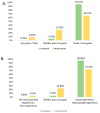The Attitudes of Healthcare Professionals in an Autonomous Community in Spain towards Paediatric Influenza Vaccination
- PMID: 38932329
- PMCID: PMC11209165
- DOI: 10.3390/vaccines12060599
The Attitudes of Healthcare Professionals in an Autonomous Community in Spain towards Paediatric Influenza Vaccination
Abstract
In the 2022-2023 influenza season, three autonomous communities anticipated the document approved by the Public Health Commission recommending influenza vaccination for all children aged 6 to 59 months. The primary objective of this study was to evaluate the attitude of healthcare professionals towards the first universal vaccination campaign in our region, as well as the acceptability of the vaccines used and their attitude towards pilot school vaccination. This was a cross-sectional, survey-based, descriptive study. All healthcare professionals involved in the campaign were invited to participate. Overall, 91.9% of surveyed professionals thought that influenza vaccination from 6 to 59 months was important or very important, and 89.8% had previous experience regarding the intramuscular vaccine. Healthcare professionals rated the intranasal vaccine significantly more positively, but there were no differences when asking about each vaccine without comparison. The inhaled vaccine was preferred by 97.5% for the following campaign. Pilot school vaccination had a 75% acceptance rate. The inhaled vaccine was preferred by most professionals, and pilot school vaccination was highly accepted and independently associated with the importance of vaccination as considered by physicians, being a medical doctor, and participation in the pilot programme.
Keywords: attitude of healthcare professionals; healthcare professional; influenza vaccines; inhaled vaccine; intramuscular vaccine.
Conflict of interest statement
The authors declare having received funding from AstraZeneca for training and dissemination activities. J.J.P.M. declares having received funding from CSL Seqirus for training and dissemination activities and M.Z.M. for training activities.
Figures




References
-
- World Health Organization Vaccines against influenza WHO position paper—November 2012. Wkly. Epidemiol. Rec. Relev. Épidémiologique Hebd. 2012;87:461–476. - PubMed
-
- European Centre for Disease Prevention and Control . ECDC Scientific Advice on Seasonal Influenza Vaccination of Children and Pregnant Women. ECDC; Stockholm, Sweden: 2012.
-
- Harper S.A., Fukuda K., Uyeki T.M., Cox N.J., Bridges C.B. Prevention and control of influenza: Recommendations of the Advisory Committee on Immunization Practices (ACIP) MMWR Recomm. Rep. 2004;53:1–40. - PubMed
-
- Smith N.M., Bresee J.S., Shay D.K., Uyeki T.M., Cox N.J., Strikas R.A. Prevention and Control of Influenza: Recommendations of the Advisory Committee on Immunization Practices (ACIP) MMWR Recomm. Rep. 2006;55:1–42. - PubMed
LinkOut - more resources
Full Text Sources

